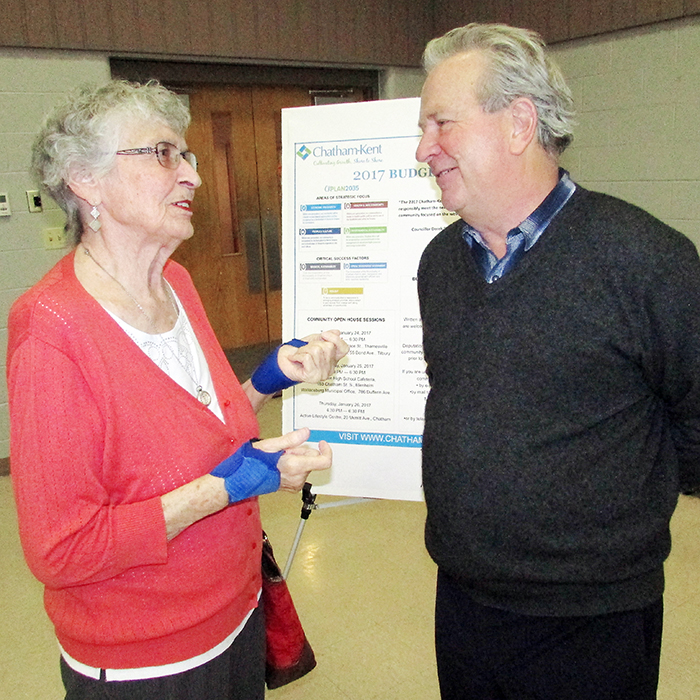
More municipal staff and councillors than curious citizens attended the Jan. 26 municipal budget open house in Chatham.
It put a final stamp on the trend this year, as municipal officials said overall, only 63 residents showed up for all five of the open houses that took place around Chatham-Kent.
Staffing levels and infrastructure questions highlighted the Chatham session, at the Active Lifestyle Centre.
Paul Shettel of the Historic Downtown Chatham BIA acknowledged the lack of public turnout at the Chatham event, adding, “But we have access to you guys.”
He expressed concern over the proposed downtown sidewalk replacement program; at the moment, sidewalks along Fourth Street aren’t in this year’s plans for replacement.
“Downtown Chatham is one of the largest commercial tax areas in Chatham-Kent. We (as business owners) invest millions of our own money in there,” he said.
Thomas Kelly, general manager of infrastructure and engineering services, said while the plan is not to replace the Fourth Street sidewalks this year, that doesn’t mean it won’t happen.
“It’s not tendered yet,” he said. “And it’s something we could look at next year.”
Marie Cadotte had questions in regard to funding levels for gravel roads in Chatham-Kent, arguing some are in very poor shape, and complaining that the surface work at times leaves much to be desired.
Cadotte also questioned Kelly’s recent proposal to tweak the spending process to ensure no more of the 850 bridges in Chatham-Kent are closed. She argued some of the bridges aren’t needed, given how quickly residents can get around in vehicles today, compared to when they went in many years ago.
“Some bridges, I question why they were built there.”
Kelly couldn’t disagree.
“We have a road network and a bridge network that was designed for the horse and buggy,” he said. “We get out to every bridge in Chatham-Kent at least every two years to do an assessment.”
Questions arose regarding economic development spending versus success. Michael Burton, director of investment attraction and government affairs for the municipality, said about 70 per cent of his department’s budget is spent working with existing businesses to help them grow. With the unemployment rate down to just over six per cent, the municipality is in good shape, he added.
Burton said the biggest concerns companies have when looking to possibly locate here are availability of workforce, logistics, and the price of electricity in the province.
Availability of workforce impacts more than just companies looking for skilled tradespeople, he added.
“We had a company wanting to hire 500 people, but it was a call centre. We don’t have the people to fill it,” he said. “The existing call centres here are struggling to fill their vacancies. Availability of workforce – if you haven’t got it, they won’t consider it.”
John Cryderman, who in late fall spoke to a provincial committee about government spending, addressed the gathering at the open house Thursday. He stressed municipal governments across the province must curtail spending, including when funding from senior levels of government are available, because that money comes from the same place – the taxpayer.
“The more the province has to kick back to communities means more income taxes,” he said. “We’ve got to put more disposable income back into the hands of the taxpayers.”
The draft budget that council will use as its starting point has a proposed increase of 1.96 per cent.
Council will meet beginning Feb. 1 to finalize this year’s budget. Start times for the Feb. 1, 2, 7 and 8 meetings are 6 p.m. in council chambers.






